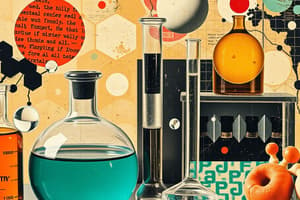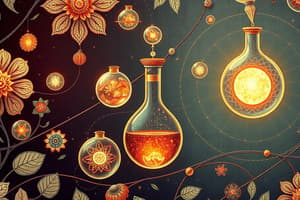Podcast
Questions and Answers
Which characteristics distinguish chemistry from other sciences?
Which characteristics distinguish chemistry from other sciences?
- Its exclusive use of mathematical models to describe natural phenomena.
- Its study of the composition, structure, properties, and interactions of matter at the atomic and molecular level. (correct)
- Its focus on biological systems and living organisms.
- Its primary concern with large-scale geological processes and formations.
How did the pursuit of the Philosopher's Stone and the Elixir of Life influence the development of early chemistry?
How did the pursuit of the Philosopher's Stone and the Elixir of Life influence the development of early chemistry?
- They spurred experimental investigations and alchemical practices that contributed to the development of chemical techniques and knowledge. (correct)
- They led to the discovery of fundamental laws of thermodynamics.
- They resulted in the creation of the first synthetic polymers.
- They established the basis for modern organic chemistry.
What evidence from Mohenjo-daro and Harappa indicates the presence of chemical knowledge and development in ancient India?
What evidence from Mohenjo-daro and Harappa indicates the presence of chemical knowledge and development in ancient India?
- Elaborate urban planning and road construction.
- Findings of baked bricks, mass production of pottery, and glazed pottery remains. (correct)
- The use of standardized weights and measures for trade.
- Advanced irrigation systems and agricultural practices.
How did ancient Indian metallurgy contribute to material science?
How did ancient Indian metallurgy contribute to material science?
What is the significance of the golden glaze found in Northern India, as referenced in the content?
What is the significance of the golden glaze found in Northern India, as referenced in the content?
How does the Charak Samhita demonstrate knowledge of chemical compounds in ancient India?
How does the Charak Samhita demonstrate knowledge of chemical compounds in ancient India?
Nagarjuna's work contributed to which areas of chemistry?
Nagarjuna's work contributed to which areas of chemistry?
What practical application is attributed to Chakra Pani in the context of ancient Indian chemistry?
What practical application is attributed to Chakra Pani in the context of ancient Indian chemistry?
What aspect of the wall paintings in Ajanta and Ellora caves indicates advanced chemical knowledge?
What aspect of the wall paintings in Ajanta and Ellora caves indicates advanced chemical knowledge?
What does the Atharvaveda reveal about the use of dyes in ancient India?
What does the Atharvaveda reveal about the use of dyes in ancient India?
How does Kautilya's Arthashastra reflect an understanding of chemical processes?
How does Kautilya's Arthashastra reflect an understanding of chemical processes?
What concept did Acharya Kanada propose regarding the nature of matter?
What concept did Acharya Kanada propose regarding the nature of matter?
According to Acharya Kanada's Vaisheshika Sutra, what are the fundamental characteristics of 'Parmanu'?
According to Acharya Kanada's Vaisheshika Sutra, what are the fundamental characteristics of 'Parmanu'?
How is 'bhasma,' as described in the content, relevant to modern science?
How is 'bhasma,' as described in the content, relevant to modern science?
When did modern science, including chemistry, begin to appear in India?
When did modern science, including chemistry, begin to appear in India?
How can chemistry relate to magnetism and electricity?
How can chemistry relate to magnetism and electricity?
What is a key role of chemistry in the national economy?
What is a key role of chemistry in the national economy?
What aspect of early chemistry declined due to the introduction of Western medicine?
What aspect of early chemistry declined due to the introduction of Western medicine?
What concept of atoms and molecules are described in the reading?
What concept of atoms and molecules are described in the reading?
According to the information provided, what is needed to continue improving chemistry?
According to the information provided, what is needed to continue improving chemistry?
Flashcards
What is Chemistry?
What is Chemistry?
The science of molecules and their transformations.
Rasayan Shastra
Rasayan Shastra
An ancient tradition encompassing metallurgy, medicine, cosmetics, glass, dyes, and more.
Ancient Construction Material
Ancient Construction Material
Gypsum cement made with lime, sand and calcium carbonate.
Faience
Faience
Signup and view all the flashcards
Nagarjuna
Nagarjuna
Signup and view all the flashcards
Chakra Pani
Chakra Pani
Signup and view all the flashcards
Acharya Kanada's Theory
Acharya Kanada's Theory
Signup and view all the flashcards
Properties of Parmanu
Properties of Parmanu
Signup and view all the flashcards
Charak Samhita
Charak Samhita
Signup and view all the flashcards
Bhasma
Bhasma
Signup and view all the flashcards
Modern Chemistry
Modern Chemistry
Signup and view all the flashcards
Atom
Atom
Signup and view all the flashcards
Molecule
Molecule
Signup and view all the flashcards
Study Notes
Chemistry - Introduction
- The first unit of class 11th chemistry covers "Some Basic Concepts of Chemistry."
- The chapter aims to provide basic concepts for understanding subsequent chapters.
Defining Chemistry
- Chemistry is the science of molecules and their transformations.
- Chemistry involves studying an infinite variety of molecules created from elements, not just the elements themselves.
- Science represents continuous human efforts to systematize knowledge for understanding nature.
Historical Context of Chemistry
- Modern chemistry is a relatively recent discipline.
- Early "chemistry" emerged from the quest for the Philosopher's Stone (to transmute base metals into gold) and the Elixir of Life (for immortality).
- Ancient India possessed knowledge of scientific phenomena before modern science.
- Chemistry was mainly developed as alchemy and hydrochemistry between 1300-1600 CE.
- Modern chemistry took shape in Europe around the 18th century, influenced by traditions introduced by Arabs.
Chemistry in Ancient Traditions
- Ancient China and India had alchemical traditions.
- Ancient Indian chemistry was known as "Rasayan Shastra," "Ras Tantra," "Ras Kriya," or "Ras Vidya."
- Ancient Indian chemistry covered metallurgy, medicine, cosmetics, glass, dyes, and more.
- Excavations at Mohenjo-daro (Sindh) and Harappa (Punjab) indicate chemical knowledge and development.
- Archaeological findings confirm the use of baked bricks and mass production of pottery.
- Glazed pottery remains were discovered in Mohenjo-daro.
Materials and Techniques in Ancient India
- Gypsum cement, made with lime, sand, and calcium carbonate, was used in construction.
- Harappans created faience, a type of glazed pottery.
- Metals such as lead, silver, gold, and copper were melted and forged to create objects.
- Methods existed for improving copper's hardness using tin and arsenic.
- Glass objects dating back to 1000-900 BC have been found in South India (Maski).
- Colored glazes and metal oxides were used for coloring agents in North India (Hastinapur, Taxila).
- Copper metallurgy in India dates back to the Chalcolithic period, with evidence of indigenous extraction technologies.
Chemistry Insights from Ancient Literature
- The Rigveda mentions tanning leather and dyeing cotton, practiced around 1000-400 BC.
- Golden glaze found in Northern India remains a chemical mystery due to its unique properties and temperature control.
- Kautilya’s Arthashastra describes salt production from the sea.
Ancient Indian Chemical Knowledge
- Ancient Vedic literature contains statements about materials that align with modern scientific findings.
- Copper utensils and ornaments of iron, gold, and silver have been discovered
- Teracotta discs and painted grey pottery were found at archeological sites in North India
- Sushrut Samhita explains alkalis.
- Charak Samhita mentions knowledge of sulfuric acid, nitric acid, and oxides/sulfates/carbonates of copper, tin, zinc, and iron.
- The Rasopanishad describes gunpowder preparation.
- Tamil texts describe firework preparation, using sulfur, charcoal, saltpeter (potassium nitrate), mercury, and camphor.
Key Figures in Ancient Indian Chemistry
- Nagarjuna, an Indian scientist, was a chemist and alchemist.
- Nagarjuna’s work, "Ras Ratnakar," deals with mercury compounds.
- He discussed methods for extracting metals like gold, silver, tin, and copper.
- His book "Rasar Navam" (800 CE) describes furnaces (bhattis) and crucibles for different purposes.
Techniques and Discoveries
- Metals were identified by the color of flames when heated.
- Chakra Pani discovered mercury sulfide.
- He invented soap using mustard oil and alkalis (NaOH).
- Soapmaking in India began in the 18th century CE, using oils from castor and mahua plant seeds, and calcium carbonate.
Wall Paintings in Ancient India
- Paintings on the walls of Ajanta and Ellora caves remain in good condition, indicating notable chemical knowledge.
- Varahamihira's Brihat Samhita (6th century CE) describes preparing glutinous materials for construction using plant-based ingredients.
Dyes and Perfumes
- Atharvaveda (around 1000 BC) mentions dyes made from turmeric, madder, sunflower, orpiment, cochineal, and lac.
- Varahamihira's Brihat Samhita references perfumes, cosmetics, and hair coloring recipes.
- Dyes were prepared from plants (indigo), and gunpowder was made using iron powder, black iron, steel, acidic extracts, and sour rice gruel.
- Gandhayukti describes recipes for scents, mouth perfumes, bath powders, incense, and talcum powder.
Paper and Ink
- Paper was known in India around the 7th century (as noted by Chinese traveler I-Tsing).
Fermentation
- Fermentation was known, referenced in the Vedas and Kautilya’s Arthashastra regarding wine production.
- Charak Samhita mentions ingredients for various drinks called "Asavas," made from plants, stems, flowers, leaves, wood, cereals, fruits, and sugarcane.
Understanding Matter
- Acharya Kanada (600 BC), also known as Kashyap, proposed that matter is made of indivisible particles called "Paramanu."
- Kanada's atomic theory predates Dalton's by over 2500 years.
- Kanada authored Vaisheshika Sutra, stating that substances are an aggregate of smaller units (atoms/Parmanu).
Properties of Parmanu
- Parmanu are eternal, indestructible, spherical, super-sensible, and always in motion.
- Individual Parmanu cannot be sensed by human organs.
- Different substances have different kinds of Parmanu that combine and bond through unseen forces.
Ayurvedic Medicine
- Charak Samhita is the oldest Ayurvedic text.
- Discusses treatments for diseases and the reduction of metal particle sizes (nanotechnology).
- The technique for reducing metal particle sizes is known as "bhasma," the ash residue of metals and is still used to treat certain conditions like cancer.
- Alchemy and hydrochemistry declined due to the introduction of Western medicine in the 20th century, causing a decline in indigenous techniques.
Modernization of Chemistry
- Modern science appeared in India in the late 19th century.
- European scientists introduced modern chemistry by the mid-19th century.
- This lead to the understanding Chemistry deals with the composition, structure, properties, and interactions of matter, focusing on atoms and molecules.
- All observations and theories can be explained by reference to atoms and molecules
- All theories and questions regarding what we percieve of entities boils down to if we can see, weigh, precieve or even count items.
Importance of Chemistry
- Chemistry deals with the composition, structure, properties, and interactions of matter, focusing on atoms and molecules.
- Applications of chemistry include weather patterns, brain function, and computer operations.
- The chemical industry provides fertilizers, alkali, acids, salts, dyes, polymers, drugs, soaps, detergents, metals, alloys, and new materials.
- Chemistry plays a vital role in national economy by meeting human needs in food, health care, and materials.
- Chemistry has helped develop life-saving drugs.
- Magnetism, electricity and good eyesight are vitaly interwinded within chemistry.
Conclusion
- A talented chemist is required to maintain innovation and improvements while accepting new challenges
Studying That Suits You
Use AI to generate personalized quizzes and flashcards to suit your learning preferences.




